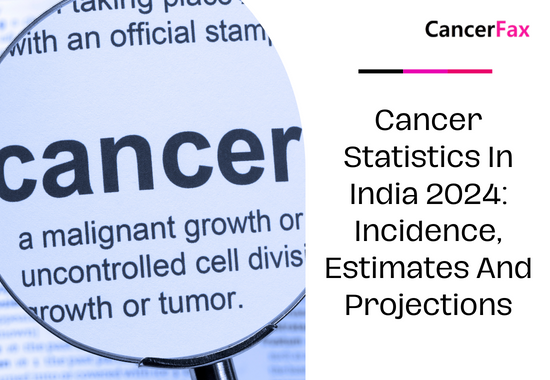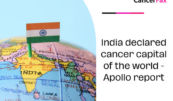Cancer statistics in India 2024: Incidence, estimates and projections
Cancer incidence, statistics, and estimates 2024: Results from National Cancer Registry Program
Cancer incidence rates are increasing at an alarming rate in India, and are anticipated to grow by 12% over the next five years. As a result, a detailed understanding of the current extent of the cancer problem is essential to developing a strategy for analyzing and regulating the impact of cancer across the country.
Recent cancer statistics are useful for planning, monitoring, and assessing cancer control actions. This article will provide an update on cancer incidence estimates in India by sex, age group, and anatomical site for the year 2022.
ICMR-NRCP Data
According to the Indian Council of Medical Research’s National Cancer Registry Programme (ICMR-NCRP), the country’s cervical cancer case count is expected to exceed 3.4 lakh by 2023, the government told Parliament on Friday.
Mansukh Mandaviya, Union Minister for Health and Family Welfare, told the Lok Sabha on February 9, 2024, that the estimated cancer prevalence in India is growing. He was referring to the Indian Council of Medical Research’s National Cancer Registry Programme.
The estimated number of cancer cases in India in 2023 is 1,496,972, up from 1,461,427 in 2022, according to the ministry.
In response to a question in the Lok Sabha, SP Singh Baghel, Union Minister of State for Health and Family Welfare, estimated that the number of cases of stomach cancer would rise to 54,023 in 2023 from 52,706 in 2022.
He also noted that breast cancer is the most common type of cancer worldwide, with an anticipated mortality rate of 665,255 in 2022. Baghel noted that India had the highest predicted number of breast cancer deaths (98,337) in 2022.In a written response to a Lok Sabha question, Minister of State for Health Satya Pal Singh Baghel stated that the Center’s Department of Health and Family Welfare provides technical and financial assistance to states and Union territories through the National Programme for Prevention and Control of Noncommunicable Diseases (NP-NCD) as part of the National Health Mission (NHM).
The minister stated that the help is offered based on the proposals submitted from the states and is subject to the resource envelope.
WHO Data
According to the World Health Organization’s (WHO) most recent estimates of the disease’s worldwide burden, India had more than 14.1 lakh new cancer cases and over 9.1 lakh deaths from the disease in 2022, with breast cancer being the most prevalent. The International Agency for Research on Cancer (IARC), WHO’s cancer agency, estimated that cancers of the lip, oral cavity, and lung were the most common in men, accounting for 15.6 and 8.5 percent of new cases, respectively, while cancers of the breast and cervix were the most common in women, accounting for nearly 27 and 18 percent of new cases, respectively.
It was estimated that almost 32.6 lakh people in India were alive within 5 years of receiving a cancer diagnosis.
Globally, the organization anticipated 2 crore new cancer diagnoses and 97 lakh deaths, with around 5.3 crore individuals living within 5 years of a cancer diagnosis. According to the report, one in every five people develops cancer at some point in their lives, and one in every nine men and one in every twelve women die from it.
In India, the chance of having cancer before the age of 75 was assessed to be 10.6%, whereas the risk of dying from cancer at the same age was found to be 7.2%. Globally, these risks were 20% and 9.6%, respectively.
The majority of nations do not appropriately fund priority cancer and palliative (pain-related) care services as part of universal health coverage (UHC), according to the WHO, which published survey data from 115 countries.
Breast Cancer Statistics in India
Breast cancer is the most frequent cancer in women, accounting for 14% of all malignancies in Indian women. According to reports, every four minutes, an Indian woman is diagnosed with breast cancer. Breast cancer rates are rising in both rural and urban India. According to a 2018 study on breast cancer statistics, 1,62,468 new cases were documented, with 87,090 reported deaths.
Cancer survival becomes more difficult as it progresses, and more than half of Indian women are diagnosed with stage 3 or 4 breast cancer. Post-cancer survival for women with breast cancer was recorded at 60% in India, compared to 80% in the United States.
Women can self-diagnose their status and detect the existence of lumps or masses that indicate malignant growths. The low breast cancer survival rate among women in India is due to a lack of awareness and inadequate early screening and diagnostic rates.
According to recent studies, Kerala has India’s highest cancer rate. Other Indian states with high cancer rates include Mizoram, Haryana, Delhi, and Karnataka. Mizoram, Kerala, and Haryana had the highest cancer death rates in the nation.
Breast cancer is the most frequent cancer type in Indian women, and women in their early thirties to fifties are at a high risk of developing it, with the incidence risk peaking between the ages of 50 and 64. One in every twenty-eight Indian women is likely to acquire breast cancer during her lifetime. It is higher (1 in 22) for urban women than in rural women (1 in 60). According to a survey, cancer accounted for 5% of total disability-adjusted life years (DALYs) in India in 2016. Palliative treatment has helped patients overcome their cancer-related impairments.
There is no escape from the fine print: breast cancer is now the most frequent type of cancer in the country, surpassing cervical cancer. Breast cancer accounts for 25% to 32% of all female cancers in places such as Mumbai, Delhi, Bengaluru, Bhopal, Kolkata, Chennai, and Ahmedabad, which is more than one-fourth of the total.
It is also more prevalent in younger age groups. Almost half of all occurrences occur in the age range of 25 to 50. Furthermore, more than 70% of cases in the advanced stage had low survival rates and significant mortality.
Breast cancer survival rates in India are low due to late detection. The only way to change these figures is to raise awareness. Breast cancer is a treatable disease, and detecting it early increases the odds of survival. The only way to do so is to understand how to recognize it and make an early diagnosis.
This involves living a healthy lifestyle and being aware of family medical histories, so if you know you’re genetically predisposed to it, you can take preventive medications or have preventive surgery. The simplest strategy to avoid breast cancer is to be able to perform a self-breast inspection. Women should do this on a regular basis, beyond the age of thirty.
Cancer burden in India
An assessment of the cancer burden in India attributed the increases to improved cancer diagnostics, cancer data gathering, and ongoing epidemiologic change. The incidence of tobacco-related, lifestyle-related, and aging-related cancers has grown over time in the tongue, mouth, colon, rectum, liver, lung, breast, corpus uteri, ovary, thyroid, prostate, gallbladder, pancreas, kidney, urinary bladder, brain, NHL, and lymphoid leukemia. Meanwhile, cancer incidence rates have decreased in the hypopharynx, oesophagus, stomach, and cervix. Alcohol consumption (30.1%) was the most significant risk factor for pharyngeal cancer-related disability-adjusted life years (DALYs). Tobacco use and air pollution (43% each) were risk factors for lung cancer DALYs, while dietary variables (43.2%) were associated with colorectal cancer.
Globally, the 65+ age group accounts for half of the cancer burden, whereas India accounts for one-third. However, half of the predicted cancer burden in India is among people aged 40 to 64. Childhood cancer affects 3% of boys and 1.8% of girls aged 0 to 14 years. The rural population in India reported a lower childhood cancer incidence rate, which could be attributable to underreporting. A study of teenage and young adult cancers found a considerable increase in incidence among males over time. The incidence of cancer cases is expected to rise to 12.8% in 2025, compared to 2020. According to a recent NCRP article, the cancer burden in India is expected to reach 29.8 million DALYs in 2025.
Conclusion
To summarize, India’s cancer incidence burden is increasing. The cervix, ovary, and corpus uteri are the three female genital organs that develop cancer most frequently in women. In males, tobacco-related malignancies were limited to three sites: the lung, mouth, and tongue. A preventative action must be implemented to reduce the future burden of cancer. The updated estimates are useful for cancer preventive and control programs in India that involve early identification, risk reduction, and management. Appropriate research, however, is required to delve deeper into the causes of the cancer burden and provide cost-effective treatments.
Dr. Nishant Mittal is a highly accomplished researcher with over 13 years of experience in the fields of cardiovascular biology and cancer research. His career is marked by significant contributions to stem cell biology, developmental biology, and innovative research techniques.
Research Highlights
Dr. Mittal's research has focused on several key areas:
1) Cardiovascular Development and Regeneration: He studied coronary vessel development and regeneration using zebrafish models1.
2) Cancer Biology: At Dartmouth College, he developed zebrafish models for studying tumor heterogeneity and clonal evolution in pancreatic cancer.
3) Developmental Biology: His doctoral work at Keio University involved identifying and characterizing medaka fish mutants with cardiovascular defects.
4) Stem Cell Research: He investigated the effects of folic acid on mouse embryonic stem cells and worked on cryopreservation techniques for hematopoietic stem cells.
Publications and Presentations
Dr. Mittal has authored several peer-reviewed publications in reputable journals such as Scientific Reports, Cardiovascular Research, and Disease Models & Mechanisms1. He has also presented his research at numerous international conferences, including the Stanford-Weill Cornell Cardiovascular Research Symposium and the Weinstein Cardiovascular Development Conference.
In summary, Dr. Nishant Mittal is a dedicated and accomplished researcher with a strong track record in cardiovascular and cancer biology, demonstrating expertise in various model systems and a commitment to advancing scientific knowledge through innovative research approaches.
- Comments Closed
- April 10th, 2024






Cancer mortality rates India, Cancer prevention India, Cancer trends India, Common cancers in India, India cancer statistics 2024, Indian cancer incidence, National cancer registry, Oncology data India
CancerFax is the most trusted online platform dedicated to connecting individuals facing advanced-stage cancer with groundbreaking cell therapies.
Send your medical reports and get a free analysis.
🌟 Join us in the fight against cancer! 🌟
Привет,
CancerFax — это самая надежная онлайн-платформа, призванная предоставить людям, столкнувшимся с раком на поздних стадиях, доступ к революционным клеточным методам лечения.
Отправьте свои медицинские заключения и получите бесплатный анализ.
🌟 Присоединяйтесь к нам в борьбе с раком! 🌟